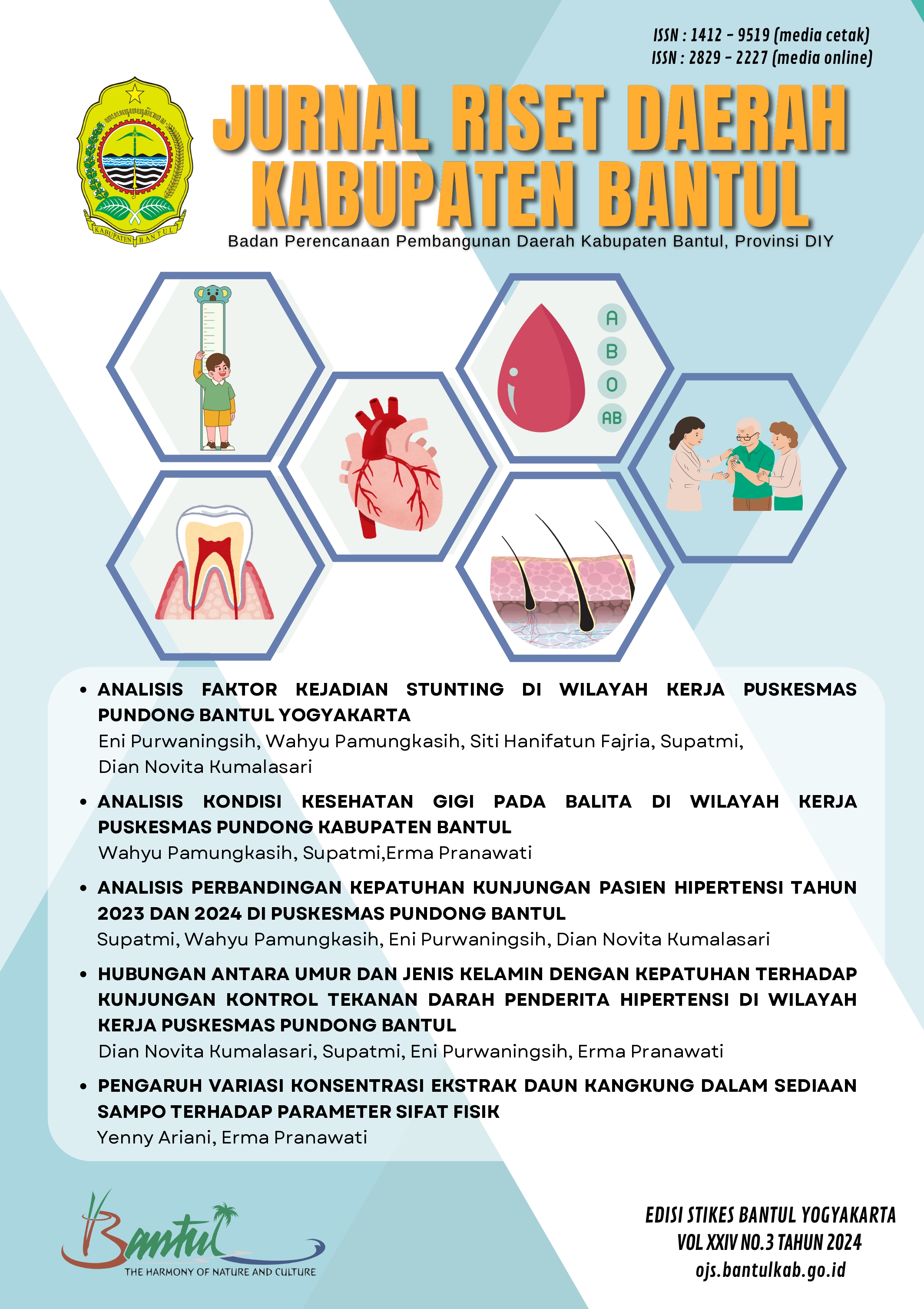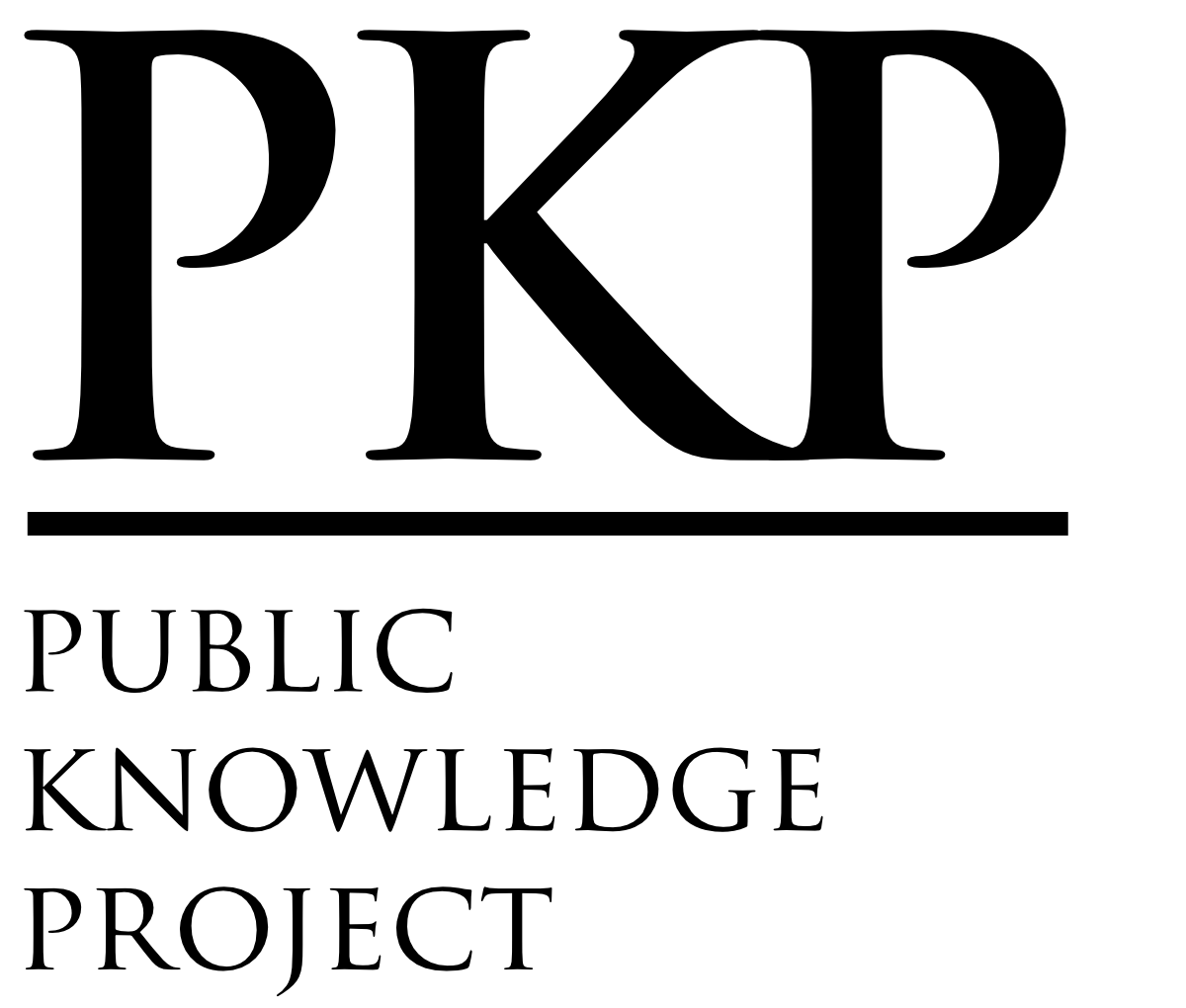ANALISIS PERBANDINGAN KEPATUHAN KUNJUNGAN PASIEN HIPERTENSI TAHUN 2023 DAN 2024 DI PUSKESMAS PUNDONG BANTUL
DOI:
https://doi.org/10.64730/jrdbantul.v24i3.121Kata Kunci:
hipertensi, kepatuhan kunjunganAbstrak
Kepatuhan kunjungan pasien hipertensi di Puskesmas Pundong menjadi perhatian utama dalam manajemen hipertensi. Penelitian ini bertujuan untuk menganalisis perbandingan kepatuhan kunjungan pasien antara tahun 2023 dan 2024, serta mengidentifikasi faktor-faktor yang mempengaruhi kepatuhan tersebut. Penelitian ini menggunakan desain cross-sectional dengan pendekatan kuantitatif. Data dikumpulkan dari dokumentasi kunjungan pasien hipertensi di Puskesmas Pundong selama periode Januari 2023 hingga Agustus 2024. Sampel diambil dengan metode purposive sampling yang melibatkan pasien yang telah didiagnosis hipertensi. Variabel yang dianalisis meliputi frekuensi kunjungan dan usia pasien. Hasil penelitian menunjukkan penurunan jumlah pasien yang menghadiri kunjungan dari 2023 ke 2024, kepatuhan pasien meningkat selama periode tersebut. Pada penelitian ini tidak ditemukan hubungan antara tingginya umur pasien dengan Tingkat kepatuhan, meskipun banyak penelitian yang menemukan bahwa kepatuhan pasien yang lebih tua cenderung memiliki tingkat kepatuhan yang lebih tinggi dibandingkan pasien yang lebih muda, kemungkinan karena peningkatan kesadaran kesehatan. Faktor-faktor seperti pengetahuan tentang hipertensi, dukungan keluarga, dan akses ke fasilitas kesehatan berperan signifikan dalam menentukan kepatuhan. Tantangan utama yang diidentifikasi termasuk kurangnya pengetahuan, kesulitan akses, dan ketidakpuasan terhadap layanan kesehatan. Meskipun terdapat penurunan jumlah kunjungan dari tahun 2023 ke 2024, tingkat kepatuhan pasien hipertensi menunjukkan peningkatan, menandakan efektivitas intervensi yang mungkin diterapkan. Pasien yang lebih tua menunjukkan kepatuhan yang lebih baik, sementara masalah seperti kurangnya pengetahuan dan kesulitan akses masih perlu diatasi. Peningkatan pendidikan pasien, dukungan keluarga, dan perbaikan sistem kesehatan merupakan langkah penting untuk meningkatkan kepatuhan dan hasil manajemen hipertensi secara keseluruhan.
Referensi
S. Pawar, “Exploring the Prevalence and Factors behind Noncompliance to Lifestyle Modification in Hypertensive patients,” International Journal of Nursing Education and Research, pp. 19–26, Mar. 2024, doi: 10.52711/2454-2660.2024.00005.
S. Sholichin, S. Exlesia, M. K. L. Rining, K. Khumaidi, and S. Syahrun, “Description of Factors that Influence Medication Compliance in Hypertension Patients at the Separi 3 Kutai Kartanegara Health Center,” Jurnal Kesehatan Pasak Bumi Kalimantan, vol. 6, no. 2, p. 254, Mar. 2024, doi: 10.30872/j.kes.pasmi.kal.v6i2.11440.
B. Das, D. Neupane, S. Singh Gill, and G. Bir Singh, “Factors affecting non‐adherence to medical appointments among patients with hypertension at public health facilities in Punjab, India,” The Journal of Clinical Hypertension, vol. 23, no. 4, pp. 713–719, Apr. 2021, doi: 10.1111/jch.14142.
K. Prihatin, B. R. Fatmawati, and M. Suprayitna, “FAKTOR-FAKTOR YANG MEMPENGARUHI KEPATUHAN BEROBAT PENDERITA HIPERTENSI,” Jurnal Ilmiah STIKES Yarsi Mataram, vol. 10, no. 2, pp. 7–16, Dec. 2022, doi: 10.57267/jisym.v10i2.64.
M. M. ur Rashid, M. M. Haque, M. S. Islam, M. F. Parvin, and A. Kahhar, “Noncompliance to Antihypertensive Medication in Patients with Essential Hypertension attending Dhaka Medical College Hospital,” TAJ: Journal of Teachers Association, vol. 35, no. 2, pp. 103–110, Jan. 2023, doi: 10.3329/taj.v35i2.63758.
B. Das, D. Neupane, S. Singh Gill, and G. Bir Singh, “Factors affecting non‐adherence to medical appointments among patients with hypertension at public health facilities in Punjab, India,” The Journal of Clinical Hypertension, vol. 23, no. 4, pp. 713–719, Apr. 2021, doi: 10.1111/jch.14142.
N. Izzati, F. B. Saputri, F. Rizky, and M. E. Saputra, “31. Evaluation of Hypertension Patient’s Adherence to Treatment in Primary Healthcare Settings Across Multiple Centers in Indonesia,” J Hypertens, vol. 41, no. Suppl 2, p. e8, Apr. 2023, doi: 10.1097/01.hjh.0000935504.96144.e0.
D. Hermaniati, Lana Sari, and Z. Zahriah, “Faktor-Faktor Terkait Kepatuhan dalam Menjalani Pengobatan pada Penderita Hipertensi di Puskesmas Gerunggang Kota Pangkalpinang,” JURNAL ILMU DAN TEKNOLOGI KESEHATAN TERPADU, vol. 4, no. 1, pp. 12–23, May 2024, doi: 10.53579/jitkt.v4i1.120.
V. E. Lanza et al., “Therapeutic Adherence According to the Morisky Scale in Patients with Hypertension,” International Journal of Cardiovascular Sciences, vol. 37, Feb. 2024, doi: 10.36660/ijcs.20220138.
C. E. Fiorillo et al., “Factors associated with patient no‐show rates in an academic otolaryngology practice,” Laryngoscope, vol. 128, no. 3, pp. 626–631, Mar. 2018, doi: 10.1002/lary.26816.
H. Jeong et al., “Medical visits, antihypertensive prescriptions and medication adherence among newly diagnosed hypertensive patients in Korea,” Environ Health Prev Med, vol. 22, no. 1, p. 10, Dec. 2017, doi: 10.1186/s12199-017-0619-6.
M. K. Pandit, K. Gaurav, and J. Kumar, “An observational study on patient compliance and adverse drug reactions of antihypertensives drugs in a tertiary care center of Bihar,” IP International Journal of Comprehensive and Advanced Pharmacology, vol. 6, no. 4, pp. 190–193, Dec. 2021, doi: 10.18231/j.ijcaap.2021.033.
G. Youssef, M. Mohamed, M. Abdel Hamid, and D. El Remisy, “Reasons behind high rate of non-compliance to scheduled office visits in hypertensive patients: results from the Egyptian registry of specialized hypertension clinics,” The Egyptian Heart Journal, vol. 74, no. 1, p. 45, Dec. 2022, doi: 10.1186/s43044-022-00285-7.
H. L. Memon, S. Z. Ahmed, and S. Muhammad, “Noncompliance to Antihypertensive Medication in Patients with Essential Hypertension,” Pakistan Journal of Medical and Health Sciences, vol. 17, no. 5, pp. 430–431, May 2023, doi: 10.53350/pjmhs2023175430.
P. E. Osamor and B. E. Owumi, “Factors Associated with Treatment Compliance in Hypertension in Southwest Nigeria,” J Health Popul Nutr, vol. 29, no. 6, Feb. 2012, doi: 10.3329/jhpn.v29i6.9899.
N. Singh, M. Rajput, P. Khanna, K. Bansal, R. Ranjan, and M. Kaur, “Knowledge and practice on drug compliance among hypertensive patients in field practice area of a tertiary health care institute in Haryana,” Int J Community Med Public Health, vol. 8, no. 3, p. 1343, Feb. 2021, doi: 10.18203/2394-6040.ijcmph20210824.
M. Gupta, D. D. Gupta, and A. Sood, “Impact of awareness about hypertension on compliance to antihypertensive medication,” Int J Basic Clin Pharmacol, vol. 7, no. 2, p. 244, Jan. 2018, doi: 10.18203/2319-2003.ijbcp20180093.
C. P. Shah, K. S. Sadananda, C. N. Makhale, M. S, and K. Kumar, “Expert Opinion on Hypertension Management: An Indian Observational Study,” The International Annals of Medicine, vol. 1, no. 10, Oct. 2017, doi: 10.24087/IAM.2017.1.10.336.
G. R. Al Farizi, R. M. Dewi, F. Gloria, and H. Widiya, “Quality of Life and Compliance Based On Hypertension Patient Characteristics At Krobokan Primary Health Center West Semarang District,” Jurnal Ilmu Farmasi dan Farmasi Klinik, vol. 21, no. 1, p. 65, Jun. 2024, doi: 10.31942/jiffk.v21i1.9455.
S. Sholichin, S. Exlesia, M. K. L. Rining, K. Khumaidi, and S. Syahrun, “Description of Factors that Influence Medication Compliance in Hypertension Patients at the Separi 3 Kutai Kartanegara Health Center,” Jurnal Kesehatan Pasak Bumi Kalimantan, vol. 6, no. 2, p. 254, Mar. 2024, doi: 10.30872/j.kes.pasmi.kal.v6i2.11440.
B. Uchmanowicz, E. A. Jankowska, I. Uchmanowicz, and D. E. Morisky, “Self-Reported Medication Adherence Measured With Morisky Medication Adherence Scales and Its Determinants in Hypertensive Patients Aged ≥60 Years: A Systematic Review and Meta-Analysis,” Front Pharmacol, vol. 10, Mar. 2019, doi: 10.3389/fphar.2019.00168.
R. Yashawant, K. Nitesh, P. Shatrughan, K. Vijay, and S. Ankur, “Medication Adherence: Assess Compliance and Associated Factors among Hypertensive Patients,” J Hypertens Manag, vol. 6, no. 1, Aug. 2020, doi: 10.23937/2474-3690/1510048.
I. A. Alhaddad, O. Hamoui, A. Hammoudeh, and S. Mallat, “Treatment adherence and quality of life in patients on antihypertensive medications in a Middle Eastern population: adherence,” Vasc Health Risk Manag, vol. Volume 12, pp. 407–413, Oct. 2016, doi: 10.2147/VHRM.S105921.
I. A. Kretchy, V. Boima, K. Agyabeng, A. Koduah, and B. Appiah, “Psycho-behavioural factors associated with medication adherence among male out-patients with hypertension in a Ghanaian hospital,” PLoS One, vol. 15, no. 1, p. e0227874, Jan. 2020, doi: 10.1371/journal.pone.0227874.
A. Chudiak, B. Jankowska-Polańska, and I. Uchmanowicz, “Effect of frailty syndrome on treatment compliance in older hypertensive patients,” Clin Interv Aging, vol. Volume 12, pp. 805–814, May 2017, doi: 10.2147/CIA.S126526.
S. Romero-Martinez, “Re: Patient Beliefs Have a Greater Impact Than Barriers on Medication Adherence in a Community Health Center,” The Journal of the American Board of Family Medicine, vol. 30, no. 6, pp. 848–848, Nov. 2017, doi: 10.3122/jabfm.2017.06.170296.
H. J. Lee, S.-I. Jang, and E.-C. Park, “Effect of adherence to antihypertensive medication on stroke incidence in patients with hypertension: a population-based retrospective cohort study,” BMJ Open, vol. 7, no. 6, p. e014486, Jun. 2017, doi: 10.1136/bmjopen-2016-014486.
S. T. Shafi and T. Shafi, “A survey of hypertension prevalence, awareness, treatment, and control in health screening camps of rural central Punjab, Pakistan,” J Epidemiol Glob Health, vol. 7, no. 2, p. 135, 2017, doi: 10.1016/j.jegh.2017.01.001.
L. Oktayanti, I. G. A. R. Widowati, I. K. Tunas, and N. P. Wintariani, “Knowledge, Attitude, and Compliance with Hypertension Patients at The Manggis I Karangasem Health Centre,” JFIOnline | Print ISSN 1412-1107 | e-ISSN 2355-696X, vol. 16, no. 1, pp. 80–88, Jan. 2024, doi: 10.35617/jfionline.v16i1.171.
M. Khwaja, M. A. Ansari, and S. Mehnaz, “Compliance to antihypertensive medication: a cross-sectional study in Aligarh,” Int J Community Med Public Health, vol. 4, no. 10, p. 3698, Sep. 2017, doi: 10.18203/2394-6040.ijcmph20174236.
M. MUHLIS, D. KARLINA, M. NAMITA, L. MARESTA, and Y. E. FEROLIA, “COMPLIANCE TO DRUG USE IN HYPERTENSIVE PATIENTS AND ITS RELATIONSHIP WITH VARIABLES AFFECTING IN THREE CITIES IN INDONESIA,” International Journal of Applied Pharmaceutics, pp. 59–61, Feb. 2021, doi: 10.22159/ijap.2021.v13s2.11.
Ebrahim Aliafsari Mamaghani, Edris Hasanpoor, Esmaiel Maghsoodi, and Farzaneh Soleimani, “Barriers to Medication Adherence among Hypertensive Patients in Deprived Rural Areas,” Ethiop J Health Sci, vol. 30, no. 1, Jan. 2020, doi: 10.4314/ejhs.v30i1.11.
H. I. Cahya, I. La Tho, and E. Muhtaruddin, “Analysis of Factors that Influence Compliance in Complete Administration of BPJS Participant Patients at The Banten Girang Puskesmas Outpatient Registration Place,” Journal Of Applied Health Research And Development, vol. 5, no. 2, pp. 109–118, Mar. 2024, doi: 10.58228/joahrd.v5i2.13.
X. Lu, “The Effects of Patient Health Information Seeking in Online Health Communities on Patient Compliance in China: Social Perspective,” J Med Internet Res, vol. 25, p. e38848, Jan. 2023, doi: 10.2196/38848.
S. Cho and J. Kim, “Factors associated with nonadherence to antihypertensive medication,” Nurs Health Sci, vol. 16, no. 4, pp. 461–467, Dec. 2014, doi: 10.1111/nhs.12145.












